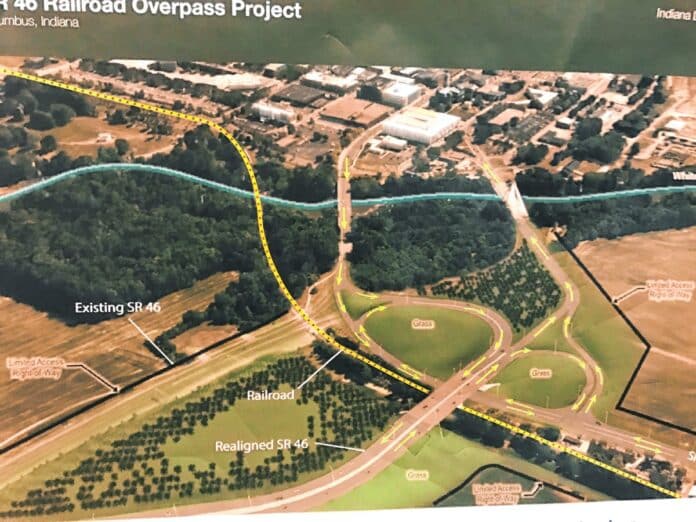
Construction of a planned railroad overpass over the State Road 46 and State Road 11 crossing on Columbus’ west side could begin in November.
More than 50 people attended a public hearing Wednesday night at Columbus City Hall to learn more details about the $30 million overpass project.
The first steps of the project will take place this summer as utility poles and other infrastructure are relocated along State Road 11, Indiana Department of Transportation officials said.
INDOT is scheduled to open bids for the project on Oct. 9, and construction could begin in late November or early December, said Dave Hayward, Columbus’ executive director of public works and city engineer.
If this winter is mild enough to allow for construction, Hayward said the overpass could be open by Nov. 15, 2020.
The good news is that the vast majority of the construction will not interfere with traffic, because it’s being done on 50.1 acres of recently acquired undeveloped land, project manager and engineer Nick Batta said. Batta works for Crawford, Murphy and Tilly — an Indianapolis-based engineering and consulting firm.
As a result, minimal traffic interruptions should be expected from now through the spring of 2020, he said.
But after that, commuters should be prepared for some traffic delays during construction.
State Road 11 will be closed right after the schools let out for the summer in 2020, with traffic detoured on to Interstate 65. Although crews plan to temporarily reopen the highway during the 2020 Bartholomew County 4-H Fair, Batta warned the roadway “isn’t going to be pretty.”
Eastbound State Road 46 will have to be reduced to one lane in the early fall of 2020, while westbound Jonathan Moore Pike will be reduced to one lane in the late fall of next year, he said.
As of now, INDOT doesn’t anticipate that the new interchange will open until the spring of 2021. And even after it does open, landscaping and other finishing work will continue through the fall of that year, Batta said.
While updating the public on the need for the $30 million investment, Batta said train volume in Columbus is expected to eventually increase from an average of two trains per day to at least 17 per day, while train lengths will grow from the current average of 5,000 feet to 7,500 feet.
Unless something is done, vehicle delays at the crossing will grow from 67 vehicle-hours to 716 vehicle hours, according to Batta.
To give west-side residents an alternative to avoid the intersection, the Bartholomew County Highway Department has been making improvements to County Road 325 West and Lowell Road. That gives motorists a link between State Road 46 West and U.S. 31 on the northwest side of Columbus.
When the overpass project is completed, one of the most noticeable changes will be the realignment of a portion of Jonathan Moore Pike (State Road 46) further to the south, Batta said.
In addition, long-established driving habits will be changed when drivers have to get in the right lane of the Third Street Bridge to head south on State Road 11 through Garden City, he said.
Likewise, those who plan to head west on Jonathan Moore Pike will get into the bridge’s left lanes before turning left and making a 180 degree turn to the right before proceeding over the overpass that is 23 feet above the railroad tracks, Batta said.
During the public hearing, John Dunlap of Columbus said he was concerned that the overpass will cause further flooding for his property that lies upstream of the East Fork White River.
Multiple floodway storage areas that exceed standards for a 100-year flood event will be constructed in the overpass area, Batta said.
The budget will not allow changes to be made to State Road 11 in the Garden City area, which often floods during major rain events, the project manager said.
Since Columbus Regional Hospital has invested in much of the land near the overpass site for development, Columbus resident Hutch Schumaker urged INDOT officials to ensure enough space remains available for adding additional traffic lanes in the future.
The third and last public comment came from Columbus resident Demetrius Villa, who advocated for the development of high-speed passenger rail service in the future.
Although the hearing is over, INDOT will continue seeking public input on environmental impacts and the proposed layout of the $30 million overpass project through June 12.
[sc:pullout-title pullout-title=”What’s next?” ][sc:pullout-text-begin]
Written comments about the overpass project may be submitted through June 12 to INDOT Public Hearings, IGCN Room N642, 100 N. Senate Ave., Indianapolis, IN 46204 or via email at [email protected].
The Indiana Dept. of Transportation is scheduled to open bids for the project on Oct. 9. Construction could begin in late November or early December, and is expected to take one year to complete.
[sc:pullout-text-end][sc:pullout-title pullout-title=”About the project” ][sc:pullout-text-begin]
Under the current design, there will be three curved, cloverleaf-like ramps at the overpass planned for the intersection of State Road 46/State Road 11 on Columbus’ west side.
The first is for drivers who are traveling north on State Road 11 and wish to take State Road 46 west. These drivers would drive underneath the overpass and then turn right to take a curved entrance ramp to merge on to the overpass.
The second curved ramp is for drivers heading east on State Road 46 who wish to travel south on State Road 11. They would cross the overpass and then take an exit ramp — similar in shape to the Interstate 65 exit ramps in Edinburgh — that curves south like a cloverleaf until intersecting with State Road 11. There would be a traffic signal at the end of the ramp to enter State Road 11.
The third curved ramp would be for drivers who are heading west from downtown Columbus and wish to travel west on Jonathan Moore Pike (State Road 46). These drivers would use the left-hand lane to take a curved entrance ramp to merge on to the overpass.
More information is available online at columbusrailroadproject.org.
[sc:pullout-text-end][sc:pullout-title pullout-title=”Overpass funding” ][sc:pullout-text-begin]
A railroad overpass was proposed after Louisville & Indiana Railroad and CSX Transportation received approval in April 2015 from the federal Surface Transportation Board to use L&I’s 106-mile mainline between Louisville and Indianapolis jointly and upgrade it from jointed steel rails to continuous welded ones. The new rails allow heavier and faster trains to move through Columbus and other cities along the rail line, from Seymour to Indianapolis.
The plan calls for CSX, which has invested $70 million to $90 million in improvements, to shift an estimated 13 to 15 trains per day to the L&I line, in addition to the L&I trains already using the line.
The overpass project was developed as a collaboration between the city and the Indiana Department of Transportation, who has agreed to pick up half of the total cost, along with other partners providing funding.
Bartholomew County is paying $1.5 million to the city, and another $500,000 that will be paid over a two-year period. The city’s share will include $4 million from Central TIF District funds.
Other funding sources include about $5.5 million from the Cummins Engine Plant TIF District funds, up to $2.5 million in state or federal highway programs along with cost savings and $1.5 million from CSX and Louisville & Indiana Railroads.
[sc:pullout-text-end]




